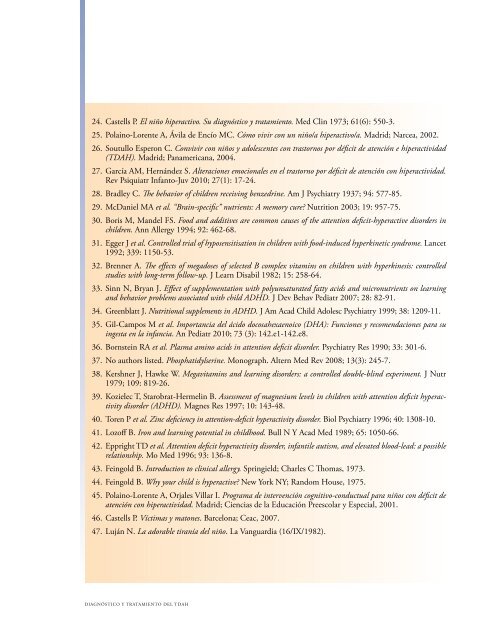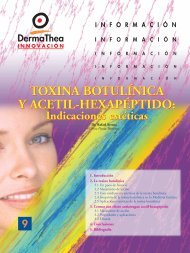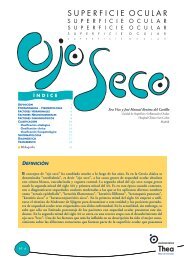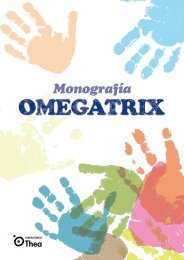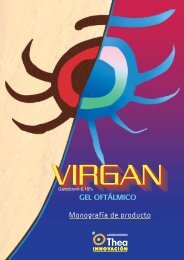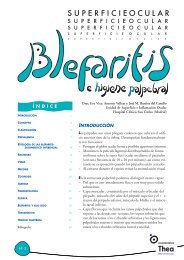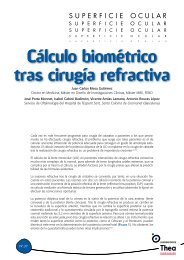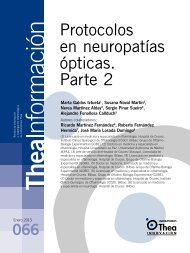I N F O R M A C I Ó N - Laboratorios Thea
I N F O R M A C I Ó N - Laboratorios Thea
I N F O R M A C I Ó N - Laboratorios Thea
You also want an ePaper? Increase the reach of your titles
YUMPU automatically turns print PDFs into web optimized ePapers that Google loves.
24. Castells P. El niño hiperactivo. Su diagnóstico y tratamiento. Med Clin 1973; 61(6): 550-3.<br />
25. Polaino-Lorente A, Ávila de Encío MC. Cómo vivir con un niño/a hiperactivo/a. Madrid; Narcea, 2002.<br />
26. Soutullo Esperon C. Convivir con niños y adolescentes con trastornos por déficit de atención e hiperactividad<br />
(TDAH). Madrid; Panamericana, 2004.<br />
27. García AM, Hernández S. Alteraciones emocionales en el trastorno por déficit de atención con hiperactividad.<br />
Rev Psiquiatr Infanto-Juv 2010; 27(1): 17-24.<br />
28. Bradley C. The behavior of children receiving benzedrine. Am J Psychiatry 1937; 94: 577-85.<br />
29. McDaniel MA et al. “Brain-specific” nutrients: A memory cure? Nutrition 2003; 19: 957-75.<br />
30. Boris M, Mandel FS. Food and additives are common causes of the attention deficit-hyperactive disorders in<br />
children. Ann Allergy 1994; 92: 462-68.<br />
31. Egger J et al. Controlled trial of hyposensitisation in children with food-induced hyperkinetic syndrome. Lancet<br />
1992; 339: 1150-53.<br />
32. Brenner A. The effects of megadoses of selected B complex vitamins on children with hyperkinesis: controlled<br />
studies with long-term follow-up. J Learn Disabil 1982; 15: 258-64.<br />
33. Sinn N, Bryan J. Effect of supplementation with polyunsaturated fatty acids and micronutrients on learning<br />
and behavior problems associated with child ADHD. J Dev Behav Pediatr 2007; 28: 82-91.<br />
34. Greenblatt J. Nutritional supplements in ADHD. J Am Acad Child Adolesc Psychiatry 1999; 38: 1209-11.<br />
35. Gil-Campos M et al. Importancia del ácido docosahexaenoico (DHA): Funciones y recomendaciones para su<br />
ingesta en la infancia. An Pediatr 2010; 73 (3): 142.e1-142.e8.<br />
36. Bornstein RA et al. Plasma amino acids in attention deficit disorder. Psychiatry Res 1990; 33: 301-6.<br />
37. No authors listed. Phosphatidylserine. Monograph. Altern Med Rev 2008; 13(3): 245-7.<br />
38. Kershner J, Hawke W. Megavitamins and learning disorders: a controlled double-blind experiment. J Nutr<br />
1979; 109: 819-26.<br />
39. Kozielec T, Starobrat-Hermelin B. Assessment of magnesium levels in children with attention deficit hyperactivity<br />
disorder (ADHD). Magnes Res 1997; 10: 143-48.<br />
40. Toren P et al. Zinc deficiency in attention-deficit hyperactivity disorder. Biol Psychiatry 1996; 40: 1308-10.<br />
41. Lozoff B. Iron and learning potential in childhood. Bull N Y Acad Med 1989; 65: 1050-66.<br />
42. Eppright TD et al. Attention deficit hyperactivity disorder, infantile autism, and elevated blood-lead: a possible<br />
relationship. Mo Med 1996; 93: 136-8.<br />
43. Feingold B. Introduction to clinical allergy. Springield; Charles C Thomas, 1973.<br />
44. Feingold B. Why your child is hyperactive? New York NY; Random House, 1975.<br />
45. Polaino-Lorente A, Orjales Villar I. Programa de intervención cognitivo-conductual para niños con déficit de<br />
atención con hiperactividad. Madrid; Ciencias de la Educación Preescolar y Especial, 2001.<br />
46. Castells P. Víctimas y matones. Barcelona; Ceac, 2007.<br />
47. Luján N. La adorable tiranía del niño. La Vanguardia (16/IX/1982).<br />
DIAGN<strong>Ó</strong>STICO Y TRATAMIENTO DEL TDAH


